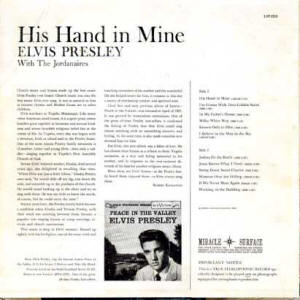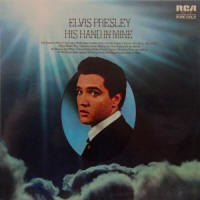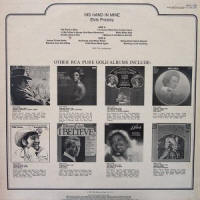Verdict
One can hear Elvis' enthusiasm for Christian music in every single note. Vocally the king was at a first peak and the track list is well chosen. I am not religious by any means, but I like this album very much.
![]()
(C) RCA Victor
The ultimate site about the king of the analogue age


Just in time for the Xmas business RCA Victor released the gospel album "His Hand In Mine" in November 1960. On January 9, 1961 the record entered the "Top LPs Chart", had a run of 20 weeks and peaked at number 13. In 1969 the RIAA honored the domestic sales with a Gold Award, in December 1977 the status was updated to Platinum. Worldwide RCA Victor was able to retail 3.5 million copies, which translates to 525 million paid streams of the complete album or 5.25 billion paid streams of individual tracks. Therefore "His Hand In Mine" couldn't compete with the soundtrack album "G.I. Blues", but it was on par with best sellers a' la "Elvis" (1956).
In 2016 the complete Presley catalogue was restored and remastered by Vic Anesini for a boxed set of 60 compact discs called "The Album Collection". Sony Music Entertainment provides the streaming platforms with the same versions of the individual albums (some of them offering bonus tracks), albeit in 24 bit/90 khz flac. That means, if the platform of your choice supports high resolution audio, you can enjoy the tracks in the same quality Sony used to scan and master them. On Spotify, which has a market share of approximately 30% and is the only platform that publishes streaming figures, "His Hand In Mine" accumulates 68 million streams and therefore is far away from the popularity of Elvis' first album. But it has to be added, that Sony/BMG also released a compilation named "Peace In The Valley - The Complete Gospel Recordings", which clocks in at 250 million streams and is requested more than 75,000 times per day.
For the cover the king was shot in suit and tie on a piano. The session took place on August 25, 1960 in Beverly Hills and generated several other promo photos. Elvis is wearing a button, that discloses him as a karate black belt. The backside of the sleeve includes liner notes and an advertising for the gospel ep "Peace In The Valley" (1957). In 1976 "His Hand In Mine" was re-released as a part of the "pure gold" series with a different cover.


The album was recorded in a single session on October 30, 1960 at RCA Studio B in Nashville/Tennessee. Besides the tracks of this album Elvis also taped "Surrender" (his forthcoming single) and "Crying In The Chapel" (released in 1965). The session was produced by Steve Sholes and engineered by Bill Porter. The band consisted of Elvis (guitar), Scotty Moore (guitar), D.J. Fontana (drums), Hank Garland (guitar), Bob Moore (bass), Murrey Harman (drums), Floyd Cramer (piano) and Homer Randolph (saxophone). The harmony vocals were provided by The Jordanaires (Gordon Stoker, Hoyt Hawkins, Neal Matthews and Ray Walker) as well as Millie Kirkham and Charlie Hodge. In total the album has a running time of 28:08 minutes.
In 2006 Follow That Dream Records released a collector's edition of "His Hand In Mine", which also included outtakes. Fifteen years later the label issued a boxed set with the masters as well as the complete session. For the reviews tap here (Collector's Edition) and here (Session Box).
His Hand In Mine
The hymn was written by Mosie Lister, the composer and arranger of The Statesmen. The group had released the song in 1953 and it was a favorite of Gladys and Vernon Presley. Elvis recorded five takes of "His Hand In Mine", the master was spliced of the takes 5 and 4. The harmony voice was provided by Charlie Hodge. I like the song very much. RCA Victor re-released it in 1969 on a single, coupled with "How Great Thou Art". But the record sold so little copies, that it didn't even chart.
I'm Gonna Walk Them Golden StairsThis is one of my favorites on the album. Elvis recorded five takes, but in the end he selected the first one for release. In 1948 the song was written by Cully Holt, by then the bass singer of The Jordanaires. At the time the king recorded "I'm Gonna Walk Them Golden Stairs" everyone thought it was on public domain. To save him from hard negotiations with Colonel Parker, Gordon Stoker adviced Cully to let them believe the track was without copyright until the album was released.
In My Father's HouseElvis recorded eight takes of the song, but to create the master a workpart-take was needed. The song was written by Ailecne Hanks and was recorded for the first time by The Blackwood Brothers in 1954. The group was another of Gladys' and Vernon's favorites.
Milky White WayOne of the album's highlights is "Milky White Way". It's not known, who wrote the song, but Elvis' version definitely was inspired by the version of The Trumpeteers, which was released in 1947. The king's performance has such a great, relaxed groove and the singer couldn't have sounded any better. He needed eight takes to archive this performance. In February 1966 RCA re-released "Milky White Way" together with "Swing Down Sweet Chariot" on a single, but it sold just 40,000 units and never charted.
Known Only To HimThis one was also issued in early 1966, but "Joshua Fit The Battle" / "Known Only To Him" was as unsuccessful as the afore mentioned gospel single. The hymn was written by Steward Hamblen and recorded by The Statesmen as well as The Blackwood Brothers. Elvis needed five attempts to get "Known Only To Him" right.
I Believe In The Man In The Sky"I Believe In The Man In The Sky" was also from The Statesmen's repertoire. Elvis performed the song a bit faster, but otherwise he copied their arrangement. Take 4 became the master. The song was written by Richard Howard.
Joshua Fit The BattleWhile serving the US Army in (West-) Germany Elvis was made aware of The Golden Gate Quartet by Charlie Hodge. The group was known for their uptempo songs, which also included the traditional "Joahua Fit The Battle". Of course everyone knew the song and so the king and his crew needed just four takes to nail a perfect version on tape. As mentioned before, RCA Victor re-released the track on a single in early 1966. For me, "Joshua Fit The Battle" is one of the highlights of this album.
He Knows Just What I NeedOriginally "When You Travel All Alone" was planned for the session, but Elvis desided to record "He Knows Just What I Need" instead. Both songs were written by Mosie Lister. At first Charlie Hodge sang along, but soon it turned out that the key was too high and so Millie Kirkham took over. Take 10 was selected for release.
Swing Down Sweet ChariotJust like "Joshua Fit The Battle", this song also originated from the repertoire of The Golden Gate Quartet. Once again four attempts were enough to record a perfect version of the traditional. In 1966 RCA Victor re-released the track on the b-side of "Milky White Way", two years later Elvis recorded the song again for the movie "The Trouble With Girls (And How To Get Into It)".
Mansion Over The HilltopWith "Mansion Over The Hilltop" Elvis returned to the catalogue of The Blackwood Brothers. He taped the song by Ira Stamphill within just three takes.
If We Never Meet AgainThis song was recorded even faster, everything was said and done within a single take. "If We Never Meet Again" was written by Albert Brumley, later it was sung by The Blackwood Brothers as well as by The Statesmen.
Working On The BuildingThe album closes with a song of The Jordanaires' repertoire. Elvis keeps his performance close to their version and stays in the background a bit to merge with the group. Lillian Bowles and Winifred O'Hoyle are credited as writers, but in fact "Working On The Building" is an old traditional of unknown origins.
One can hear Elvis' enthusiasm for Christian music in every single note. Vocally the king was at a first peak and the track list is well chosen. I am not religious by any means, but I like this album very much.
![]()
(C) RCA Victor